This was published 5 years ago
Tourists return to Egypt: Why Cairo, Nile, pyramids are back on bucket list
By Alison Stewart
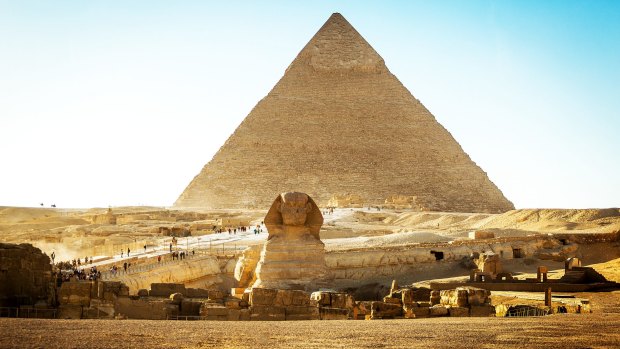
The Sphinx with The Great Pyramids of Giza.Credit: Shutterstock
For seven long years, the Great Pyramids of Giza stood forsaken, the pharaohs' tombs silent and the historic hotels abandoned after Cairo's 2011 Arab Spring, as political turmoil and security crises drove travellers from this land of antiquities.
But it is no longer Death on the Nile. As the life-giving river streams in from the Ethiopian highlands and the Great African Lakes, so the visitors are flooding back to this crucible of civilisation whose ancient world is still a model for Western culture. To understand ourselves, we must understand Egypt.
Some return with trepidation, for Egypt is still not quite itself, but the country that holds arguably the world's richest treasure trove is irresistible.
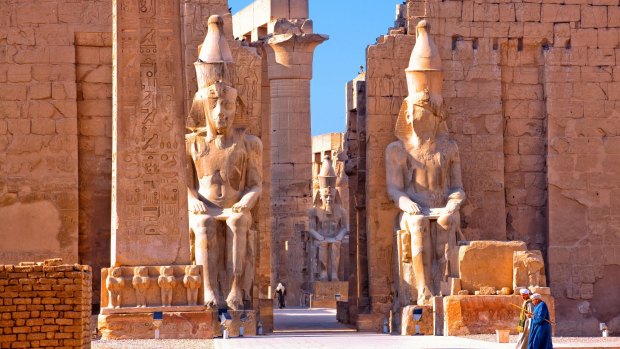
Luxor temple, Egypt.Credit: Alamy
The magnitude of the visitor desertion was traumatic, for Egypt relies on tourism. At its 2010 peak, the industry employed 12 per cent of Egypt's workers, servicing about 14.7 million visitors. Numbers dropped to 4.8 million in 2016, but almost doubled by the end of 2017 when Egypt again became one of the world's fastest growing tourist destinations.
The truth is, people cannot stay away, for this enigmatic country of more than 100 million people is not a static footnote in history. The Sahara's mercurial gilded sands, the satin slide of the Nile, the limestone and granite mountains and fertile river valley still hide treasures beyond imagining.
Egyptologists believe about 70 per cent of antiquities still lie hidden. Improvements in satellite imagery mean new discoveries occur regularly. A 3500-year-old tomb near Luxor's Valley of the Kings recently unearthed a cornucopia of sarcophagi, mummies and jewellery.
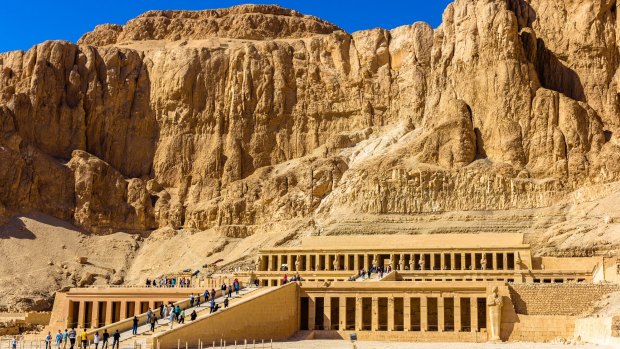
Mortuary temple of Queen Hatshepsut, Deir el-Bahari.Credit: Shutterstock
Egypt has long been a lodestone to invading Nubians, Assyrians, Persians, Greeks, Romans, Arabs, Ottoman Turks and the great march of French and British archaeologists, tomb raiders and elite voyagers for whom an expedition into Egypt was a mandatory part of the European Grand Tour.
Its glorious past had fallen into mystery but was rediscovered in the 18th and 19th centuries, influencing our understanding of the world.
The 1820s discovery of the Rosetta Stone, which bore the same text in three languages, allowed the deciphering of hieroglyphics narrating richly symbolic stories of life, death and renewal. The ancient Egyptian scripts alongside ancient Greek provided the key to a sophisticated world where life was celebrated with vigour.
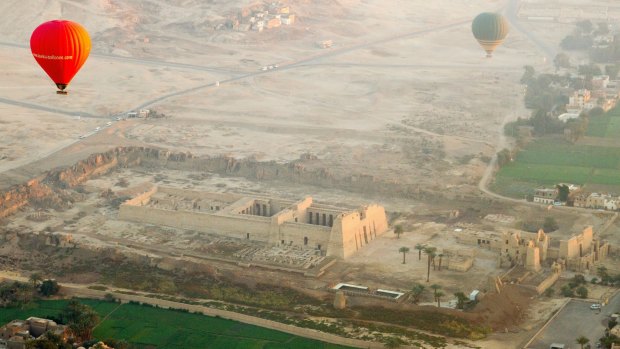
Hot air balloons over Medinet Habu.Credit: Alamy
Egypt's priceless artefacts controversially grace the museums and grand squares of many cities, including London, Paris, Istanbul, Berlin, New York and The Vatican. Despite the treasures it has lost (including the Rosetta Stone to the British Museum, Nefertiti's Bust to Berlin's Neues Museum, the Dendera Zodiac to the Louvre and a precious array of obelisks), Egypt still remains the richest of living museums.
This ancient era began in about 3100 BC with the first dynasty and ended in 30 BC with the end of the 30th dynasty and the suicide of Cleopatra VII, whom our guide likes to refer to as "Elizabeth Taylor".
Flying into Cairo, once "the city of 1000 minarets", now a metropolis with a population to match Australia's, over the fork of the Red Sea, over gleaming desert and apartment sprawl, crystallises the reality of visiting a land this writer believed was forever out-of-bounds.
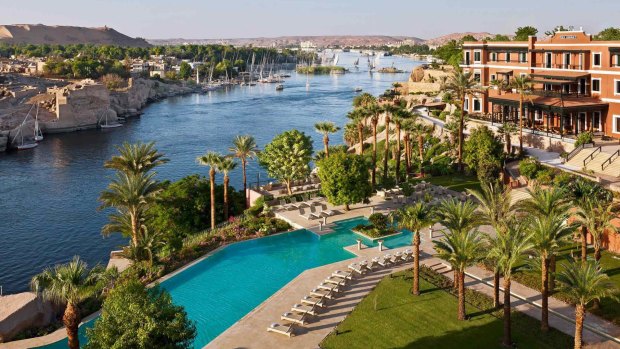
Sofitel Legend Old Cataract Aswan.
Our journey will take us almost the length of Egypt from Cairo to Abu Simbel near the Sudanese border, carried along the Nile and by internal flights to fabled places still inhabited by the ghosts of pharaohs.
Our Egyptologist guide and tour director, Salah Sholok, will weave a chronicle of Egypt's ancient world, explaining the complex chronology, dynasties, symbolism, myths, and treacheries, even the hieroglyphics.
DAYS 1 TO 2 GIZA GREAT PYRAMIDS, SPHINX AND SOLAR BOAT
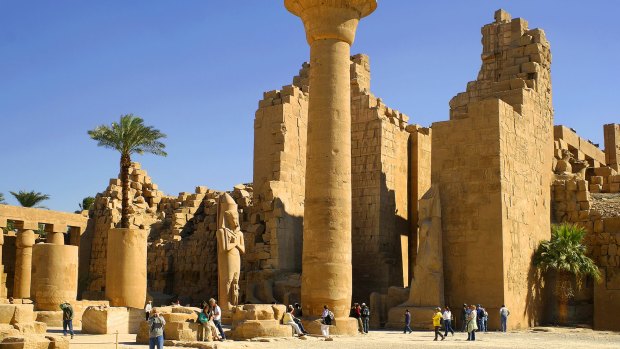
Karnak Temple in ancient Thebes is a UNESCO World Heritage Site.Credit: Shutterstock
Some people joining our journey are overcome by emotion as they trickle in for drinks on the terrace of historic Mena House, built as a royal hunting lodge for the Khedive Ismail and an Australian forces World War I oasis.
Rising rosy in the evening light is the last of the ancient world's seven wonders – Giza's Great Pyramid – that has stood for more than 4500 years. It's a wondrous sight and the first of many, for at the start of the journey, the quantity and sophistication of Egypt's antiquities is unimaginable.
Salah delivers "seven centuries in seven minutes" as we head the next day to the pyramids.
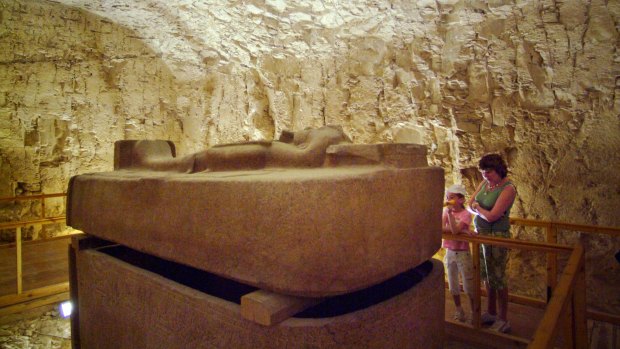
Tomb of Siptah at the Valley of the Kings at Luxor.Credit: Alamy
There were three kingdoms – Old, Middle and New, taking in the old-era pyramids, the classical middle era of high art and culture, then the final prosperous new era of strong central government. This was when great structures like Abu Simbel, Karnak and Luxor temples and the tombs of the Valley of the Kings and Queens were built.
The Great Pyramid of Khufu (Cheops), the middle pyramid, built for Khufu's son, Khafre, and the shortest, built for Khafre's son, Menkaure, are on a scale commensurate with these Old Kingdom pharaohs' godlike powers. Smaller queens' pyramids, mudbrick mustabas (tombs) for relatives and nobles surround the monoliths.
Never again would pyramids be built to this scale, though the pyramid shape remained beloved of the ancients as it represented the ascent to the sun and eternal life.
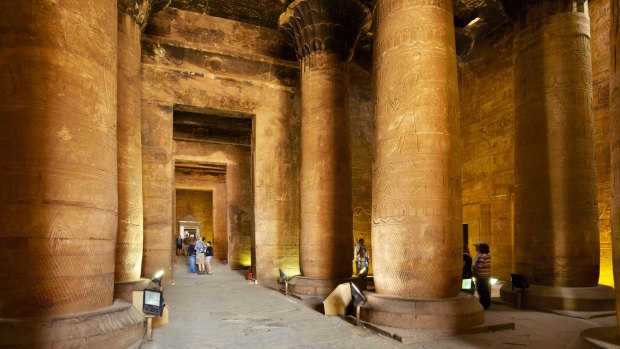
Temple of Horus.Credit: Alamy
As I climb into the Great Pyramid's innards, up countless steep rungs, bent double at times, it is best not to think too hard on the structure's scale.
With eternity and bling in mind, the pharaohs favoured limestone – lesser limestone for the blocks, fine white Tura limestone for the casing and a pyramidium limestone or granite capstone covered with gold or gold/silver alloy.
Most of the outer limestone has been stripped but the effect would have been a suitably heavenly radiance. The pyramidia have gone, though we later view the Egyptian Museum's four – the world's largest collection.
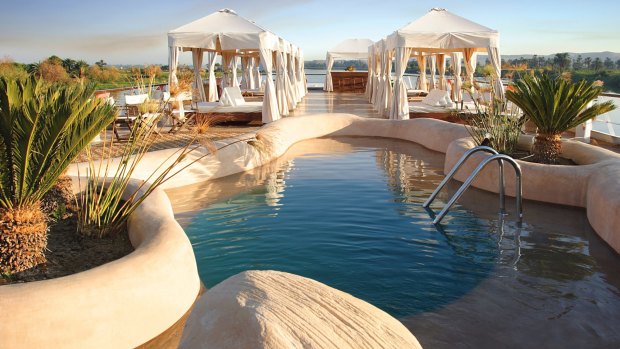
Sanctuary Sun Boat III on the Nile River.
The stairway to the king's chamber bears the weight of 6.5 million tonnes or about 2.3 million blocks of limestone – enough to almost ring the Equator.
It's stuffy, despite the engineering marvel of airshafts and there is some comfort knowing there are anti-crush "weight relief chambers". It's stood for a while; should be fine for a while longer.
We spend hours at the dramatic, sand-yellow site, with camels, ponies and carts, hawkers, hang gliders and the white-hot sky. There's the Solar Boat Museum, whose solar boats (for the eternal journey to join Ra in the two paradises – sky and underworld) have been recently unearthed and reassembled. One is on display.
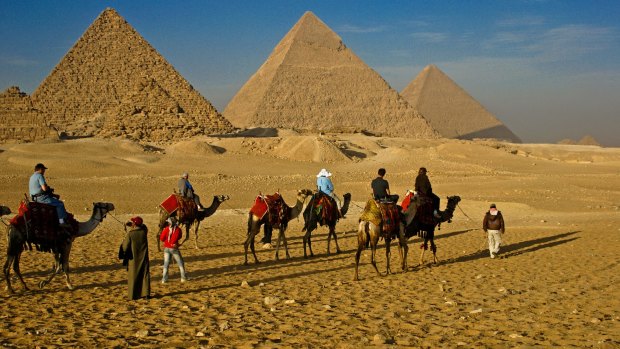
Tourists ride camels past the Pyramids of Giza.Credit: Shutterstock
Then there's the mysterious Sphinx, human head, lion body, face mutilated, which reclines enigmatically. It's generally thought to be about 4500 years old but some claim it's possibly 12,500 years old, consistent with water damage and constellation alignments.
The only absolute truth here is that it endures while all who have gazed upon it – Alexander the Great, Cleopatra, Napoleon Bonaparte – have gone to dust.
DAYS 3 TO 4 LUXOR AND THE VALLEY OF THE KINGS
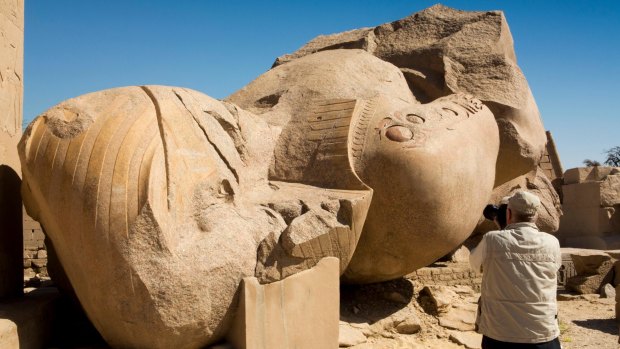
Fallen Colossus of Ramses II in Luxor.Credit: Alamy
It's an early flight to the gorgeous "open-air museum" that is Luxor, about 650 kilometres south of Giza. This is ancient Thebes, Land of the Thrones, capital of the most powerful of kings, and rich beyond imagining. It possesses two-thirds of the ancient world's antiquities.
In Luxor's Old Winter Palace, my elegant balcony will later show an evening molten path rippling across the Nile to the Western Theban necropolis.
This Victorian wedding-cake hotel, with its fragrant garden that has welcomed princes and presidents, now welcomes us with iced hibiscus karkade tea, before we launch ourselves again into Luxor. Luxor Museum is a small treasure with its mummies, hieroglyphs, alabaster and granite sculptures and the museum's masterpiece – an enigmatically smiling statue of Thutmosis III, sixth pharaoh of the 18th dynasty and son-in-law to Hatshepsut, the second female pharaoh.

Local boys holding puppy in Nubian village on the Nile.Credit: Shutterstock
We visit Queen Hatshepsut's mortuary temple the next day, but first, the fabled Valley of the Kings where royal tombs plunge into limestone crags topped with an auspicious pyramid peak.
Egypt's Old Kingdom pharaohs favoured Giza and the delta for their tombs. The New Kingdom pharaohs, concerned about looting, chose this white-hot valley on the edge of the Sahara for their royal burial ground – 64 tombs so far have been unearthed, including that of Tutankhamun, Seti I and the great Rameses II.
The temperature is nudging 40 degrees, made bearable by the anticipation of seeing the artistic virtuosity of the tombs' still colourful frescoed friezes and intricately carved bas-reliefs.

Feluccas on Nile River at Aswan, Egypt.Credit: Alamy
We enter the tombs of Rameses III, IV, VI, IX and Tutankhamun, down the long, exquisitely decorated corridors that represent the pharaohs' journey to the underworld, with riddles and obstacles to solve. The tombs' stories, told through symbolic pictorial representations and hieroglyphics in various "books" inscribed on the tomb walls, including "the Book of the Dead", are an artistic tribute to the gods and a narrative to speed the pharaoh to the eternal world.
The treasures are mostly gone, though Tutankhamun's pitiful little mummy remains. Later in the Egyptian Museum, we view his dazzlingly vast tomb and its contents, discovered intact in 1922 by British archaeologist Howard Carter. They are bound for the New Egyptian Museum nearing completion in Giza. He died at 19, possibly from gangrene, and it seems wrong to be gazing on him.
This feeling of intrusion continues when I descend into Seti I's tomb – at a cost of an extra 1000LE (about $100). The hefty price tag means it's deserted, as in the pharaohs' time, when tombs were sealed.
I'm glad I came. It's a veritable underground city. The high art and culture of Seti I's reign are evident in the sophisticated bas-reliefs and colourful decorations.
The Theban necropolis offers more treasures – the Valley of the Queens with the tomb of Nefertari, wife of Rameses II and the two massive Colossi of Memnon, representing Amenhotep the Magnificent, which stood before his mortuary temple. It was once the most opulent in Egypt before flood and earthquake reduced it.
One colossus "sang" at dawn like a mysterious oracle, drawing Roman emperors (dew evaporating in cracks is the prosaic explanation).
Rameses III's Medinet Habu mortuary temple is remarkable for its peristyle hall column details and ceiling decorations, but also for the carving of a pile of unfortunate male genitals – an unusual accounting method to show enemy deaths.
And finally the massive fallen statue of Rameses II, the most powerful pharaoh, son of Seti I, named Ozymandias by the Greeks.
Shelley wrote his sonnet, Ozymandias, in 1811, on viewing this fallen giant, "My name is Ozymandias, King of Kings; Look on my Works, ye Mighty, and despair! Nothing beside remains …" Is this the kind of immortality Rameses the Great had in mind, one wonders?
DAYS 4 TO 7 THE NILE, KARNAK AND LUXOR TEMPLES
We join our Nile cruise at Luxor for the four-night journey to Aswan, following the pharaohs' procession. Our Sanctuary Sun Boat III, with its 1920s/'30s ambience, has only 18 cabins, most quite compact – it's an "intimate river yacht" – though there are four royal/presidential suites. The spaciousness is in the pleasing common areas.
The staff are excellent. Gentle chef Hamman – once Richard Gere's chef – teaches us how to cook several of his Egyptian specialties.
A late afternoon visit delivers us to the Karnak Temple complex dedicated to Amun-Ra and Mut, the world's largest religious building, bigger than Cambodia's Angkor Wat. Three cathedrals the size of Notre Dame would fit within the great inner temple, while the Hypostyle Hall with 134 massive columns must be seen to be believed.
Called "The Dazzling" for its once-gilded hieroglyphics, Karnak was, with Luxor Temple, integral to the annual, 27-day Opet regeneration festival, which celebrated the Amun-pharaoh connection.
Opet featured a sacred procession between the temples along the Avenue of the Sphinxes, which is currently being excavated and restored. Soon, people will be able to walk the 2.6-kilometre route lined with about 1200 sphinxes.
A vicious western Saharan sandstorm drives us from Karnak. About 2500 years ago, a 50,000-strong Persian army was consumed by just such a storm, never to be found. We hotfoot it back to the ship.
The next evening, it's Luxor Temple, whose gates glow golden in the setting sun and feature the Rameses II's battle against the Hittites at Kadesh in Syria, which he apparently won single-handedly (a draw, actually).
Industrious Rameses, who fathered more than 90 sons and 60 daughters, must however be credited with signing the world's first peace treaty with the Hittites, a copy of which hangs in the United Nations.
The next few days are a whirl, literally, of dervishes, belly dancers, traditional galabeyya nights, and more glorious temples including Dendera's Hathor Temple.
Hathor shines with a magnificent turquoise temple ceiling, the only remaining engraving of Cleopatra and Caesarion – her son by Julius Caesar – and its zodiac room, showing the ancients' astrological superiority.
The Temple of Horus at Edfu is the most well preserved ancient temple, while Kom Ombo Temple is an unusual double temple with sanctuaries dedicated to the crocodile god, Sobek and Horus. Rather striking is its mummified croc museum and the entrance-gate snake charmer with hooded cobra, which I narrowly avoid stepping on in the dusk.
For dusk it must be, as daytime temperatures are climbing into the 40s as we float south. At Aswan and Abu Simbel, it will be 47 degrees as the desert closes in.
DAYS 8 TO 11 ASWAN, PHILAE TEMPLE, ABU SIMBEL, CAIRO
The Nile valley stands in stark contrast to the line of Sahara that shoulders the fertile plain. Here at Aswan, and further south at Abu Simbel, the desert pushes right in, leaving only a green fringe. Hard to imagine that lush forests and rivers once covered the western Sahara. One of the world's driest regions is now yielding the fossilised remains of whales. The Valley of the Whales at Wadi al-Hitan, 150 kilometres southwest of Cairo, proves the existence of a vast ocean.
As the climate changed, people crept closer to the Nile and it is along this serene river that we float, nearing the end of our cruise.
Aswan is unexpectedly beautiful, the upper reaches of the Nile above the dam splitting into channels, with velvet green islands and feluccas silhouetted against buttery Nubian Desert. Then there's our hotel – the Old Cataract, built in 1899, its name taken from the marriage of the river and the granite wall that formed the first of the seven Nile cataracts.
This is where Agatha Christie wrote Death on the Nile and Egypt-mad Winston Churchill came in 1902. My eyrie room shows the sweep of the Nile, Elephantine Island, and the Aga Khan's massive tomb on a desert dune.
We visit the unfinished obelisk, which gives a lesson in the ancients' sophisticated engineering techniques. There's a peaceful felucca outing, a Nubian village with hot red karkade, and a motorboat trip to the Philae Temple complex, dedicated primarily to Isis on Agilkia Island in the reservoir downstream of the Aswan Dam. Philae is remarkable for being shifted piecemeal to save it from the high dam's flooding.
Another Herculean engineering feat is the relocation of the Abu Simbel rock temples, one of which bears the colossal seated statues of Rameses II. Originally these temples were cut into a solid rock cliff at the second cataract but were moved for Lake Nasser, which incidentally swarms with about 10,000 Nile crocs.
We've flown about 230 kilometres from Aswan to the western bank of Lake Nasser to view these shifted wonders. It's extraordinarily hot, someone faints, for the walk to the temples is gruelling. No one complains, for no one would have missed the wonder that is Abu Simbel. We're whisked back to Cairo and the cool surrounds of the Nile Ritz-Carlton on Tahrir Square, birthplace of the Arab Spring.
Cairo offers up its riches along with crazy traffic. There's the incredible Egyptian Museum to round out our antiquities binge, Islamic Cairo, Coptic Cairo, and the Khan Al-Khalili bazaar. Too soon, we must leave this vivid country. I do so accompanied by these words from the ancient Egyptian Book of the Dead, proving that a civil society is not a new concept: What I hate is ignorance, smallness of imagination, the eye that sees no farther than its own lashes.
All things are possible … Who you are is limited only by who you think you are.
EGYPT: A REFRESHER COURSE
HEALTH
Don't drink tap water, even for cleaning teeth. No ice in drinks. Avoid salad leaves, uncooked vegetables and unpeeled fruit. Tour provides abundant bottled water. The World Health Organisation recommends typhoid, hepatitis A and B, cholera, polio, yellow fever, rabies, and influenza vaccines. Doctor on board the cruise.
MONEY AND VISAS
Scenic meets guests pre-customs, assists with visa ($US25). ATMs accept credit/debit cards and rate is pretty standard. Expect some small extra costs – tomb, temple and museum photography costs between 50LE ($3.75) and 300LE. Extra tomb visits in the Valley of the Kings cost between 80LE and 1000LE.
TIPPING
Scenic covers most tipping but small tips for toilet attendants etc are appreciated.
HAWKERS AND RETAILERS
Egyptians suggest you make no eye contact to avoid pestering. If you say, "See you later", you will see them later. Bargaining is expected – expect to pay 50 per cent of the original quote. A few Arabic words like "shukran" (thank you) are helpful. Egyptians are generally warm and friendly.
CLOTHING
Appropriate dress for this mostly Muslim country is appreciated (covered shoulders and below-the-knee attire). Non-revealing Western dress is acceptable in more liberal Egypt. Significant walking required so take good shoes.
SECURITY
The Australian government advises, "Reconsider your need to travel". Consequently, Scenic has taken the following steps: Cairo-based operations team pre-checks sites and monitors security, the Egyptian tour director travels with guests and stays in touch with the Cairo team. Scenic's partners employ security measures, hotels have security screening and the cruise is a private charter with security guards and police guards.
EGYPT: FIRING THE IMAGINATION FIVE WAYS
READ IT
Egypt is the bridge between the Middle East and Africa with a strong literary culture. Egyptian Naguib Mahfouz won a Nobel Prize for Literature for novels including The Cairo Trilogy. Seek out the oasis that is the writer's eponymous cafe when you visit Cairo's Khan Al-Khalili souk. Order karkadeh, the gorgeous hibiscus-infused tea. No sugar needed.
WATCH IT
Yul Brynner starred in the 1956 film, The Ten Commandments, playing Rameses II as the pharaoh of the Exodus – debatable.
HEAR IT
Verdi's Egyptian-themed opera Aida, first performed in Cairo's Khedivial Opera House in 1871, was performed recently at Giza's Pyramids.
EXPLORE IT
Lawrence Durrell's The Alexandria Quartet evocatively explores mid-20th century Alexandria.
RIDE IT
Steven Spielberg's 1981 top-grossing film, Indiana Jones and the Raiders of the lost Ark, has Nazis and Egyptian antiquities. What could possibly go wrong?
FLY
Etihad flies to Abu Dhabi and Egypt Air flies from Abu Dhabi to Cairo. See etihad.com
STAY
Scenic's 11-Day Treasures of Egypt journey from Cairo to Abu Simbel includes a four-night Nile cruise on Sanctuary Sun Boat III, four luxury hotel stays, Egyptologist tour director/guide, multiple temple, tomb and museum visits, internal flights, most meals, accommodation, tipping, complimentary wine with lunch and dinner. Prices from $9095 per person twin share, departing Giza (Cairo) on May 10, 2019. See scenic.com.au or phone 138 128. For the Sanctuary Sun Boat III, see sanctuaryretreats.com
Alison Stewart travelled as a guest of Scenic.
Sign up for the Traveller Deals newsletter
Get exclusive travel deals delivered straight to your inbox. Sign up now.